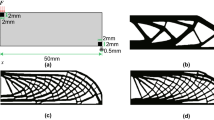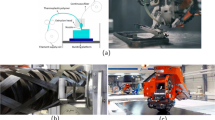Abstract
In recent years, the field of additive manufacturing (AM), often referred to as 3D printing, has seen tremendous growth and radically changed the way we describe valid 3D models for fabrication. While not free of constraints, AM offers an unprecedented level of freedom in geometrical complexity for manufacturable feasible designs. One example of such design freedom is the creation of intricate, robust, and lightweight internal structures. Our approach builds upon and extends the recent works on topology optimization for the so-called infill structures. In order to have more design control over these infill structures, we present a new formulation allowing the generation of mixed design patterns containing bulk and porous regions using a guiding constraint parameterized by non-uniform constraining fields. Secondly, we demonstrate multiple methods of generating such non-uniform fields to leverage the present formulation and analyze their effect on the geometrical and physical properties of the obtained designs.






















Similar content being viewed by others
References
Amir O, Aage N, Lazarov BS (2014) On multigrid-CG for efficient topology optimization. Struct Multidiscip Optim 49(5):815–829
Bendsøe MP (1983) On obtaining a solution to optimization problems for solid, elastic plates by restriction of the design space. Mech Based Des Struct Mach 11:501–521
Bendsøe MP (1989) Optimal shape design as a material distribution problem. Structural Optimization 1 (4):193–202
Bendsøe MP, Kikuchi N (1988) Generating optimal topologies in structural design using a homogenization method. Comput Methods Appl Mech Eng 71(2):197–224
Bendsøe MP, Sigmund O (1999) Material interpolation schemes in topology optimization. Arch Appl Mech 69(9):635–654
Bendsøe MP, Sigmund O (2003) Topology optimization - Theory, methods and applications. Springer, Germany
Clausen A, Aage N, Sigmund O (2016) Exploiting additive manufacturing infill in topology optimization for improved buckling load. Engineering 2(2):250–257
Clausen A, Andreassen E, Sigmund O (2017) Topology optimization of 3D shell structures with porous infill. Acta Mech Sinica, pp 1–14
Díaz A., Sigmund O (1995) Checkerboard patterns in layout optimization. Structural Optimization 10 (1):40–45
Dick C, Georgii J, Westermann R (2011) A real-time multigrid finite hexahedra method for elasticity simulation using CUDA. Simul Model Pract Theory 19(2):801–816
Gao W, Zhang Y, Ramanujan D, Ramani K, Chen Y, Williams C, Wang C, Shin Y, Zhang S, Zavattieri P (2015) The status, challenges, and future of additive manufacturing in engineering. Comput Aided Des 69:65–89
Liu L, Shamir A, Wang C, Whitening E (2014) 3D printing oriented design: geometry and optimization. In: SIGGRAPH Asia 2014 Courses, SA ’14, ACM, New York
Schmidt S, Schulz V (2011) A 2589 line topology optimization code written for the graphics card. Comput Vis Sci 14(6):249–256
Sigmund O, Maute K (2012) Sensitivity filtering from a continuum mechanics perspective. Struct Multidiscip Optim 46(4):471–475
Sigmund O, Maute K (2013) Topology optimization approaches a comparative review. Struct Multidiscip Optim 48:1031–1055
Sigmund O, Petersson J (1998) Numerical instabilities in topology optimization: a survey on procedures dealing with checkerboards, mesh-dependencies and local minima. Structural optimization 16(1):68–75
Sigmund O, Aage N, Andreassen E (2016) On the (non-)optimality of Michell structures. Struct Multidiscip Optim 54(2):361–373
Svanberg K (1987) The method of moving asymptotes - a new method for structural optimization. Int J Numer Methods Eng 24(2):359–373
von Neumann J, Goldstine H (1947) Numerical inverting of matrices of high order. Bull Am Math Soc 53 (11):1021–1099
Wang F, Lazarov BS, Sigmund O (2011) On projection methods, convergence and robust formulations in topology optimization. Struct Multidiscip Optim 43(6):767–784
Wu J, Aage N, Westermann R, Sigmund O (2016a) Infill optimization for additive manufacturing - approaching bone-like porous structures. IEEE Trans Vis Comput Graph 24:1127–1140
Wu J, Dick C, Westermann R (2016b) A system for high-resolution topology optimization. IEEE Trans Vis Comput Graph 22(3):1195–1208
Acknowledgements
The authors are thankful to the reviewers for their insightful comments helping improve the paper and to the members of the Department of Mechanical Engineering and Department of Electrical Engineering of the Technical University of Denmark for the organization of the 2017 PhD course “Topology Optimization - Theory, Methods and Applications.” C. Gout thanks M2SiNum project (co-financed by the European Union and by the Normandie Regional Council) and CIEMME OpenMod platform (INSA Rouen) for their support.
Author information
Authors and Affiliations
Corresponding author
Ethics declarations
Conflict of interest
The authors declare that they have no conflict of interest.
Replication of results
Unless explicitly stated, all optimized designs of the present paper used the following parameters: γ = 3, Y 0 = 1Ymin = 10− 6, \(G_{l}^{\star }= 0.6\), Poisson ratio of 0.3, isotropic local neighborhood of radius rE = 4, a sensitivity filter of radius 1.3 with elements of size 1 arranged in a regular 2D or 3D grid of squares or cubes, respectively.
Additional information
Responsible Editor: W. H. Zhang
Publisher’s note
Springer Nature remains neutral with regard to jurisdictional claims in published maps and institutional affiliations.
Rights and permissions
About this article
Cite this article
Schmidt, MP., Pedersen, C.B.W. & Gout, C. On structural topology optimization using graded porosity control. Struct Multidisc Optim 60, 1437–1453 (2019). https://doi.org/10.1007/s00158-019-02275-x
Received:
Revised:
Accepted:
Published:
Issue Date:
DOI: https://doi.org/10.1007/s00158-019-02275-x




